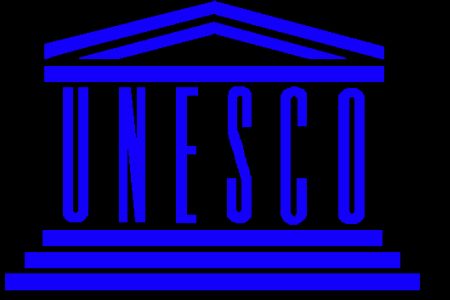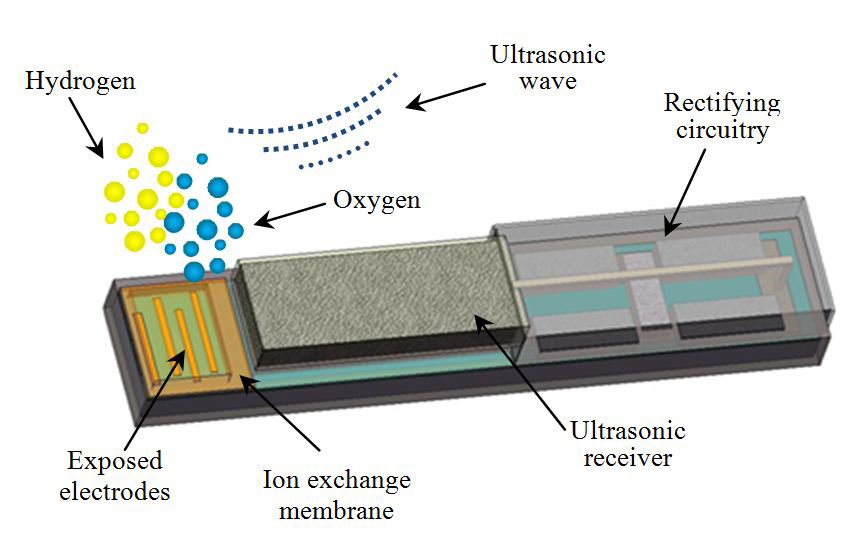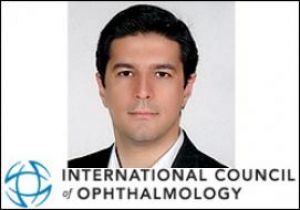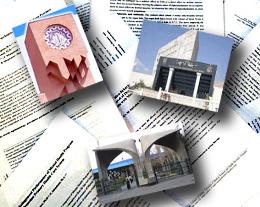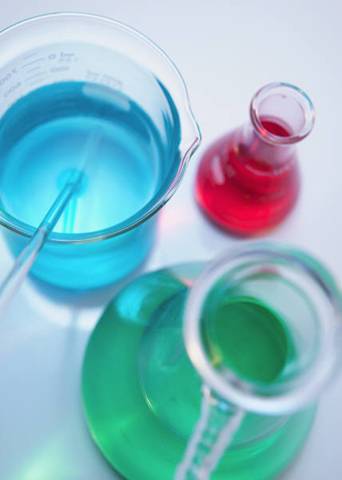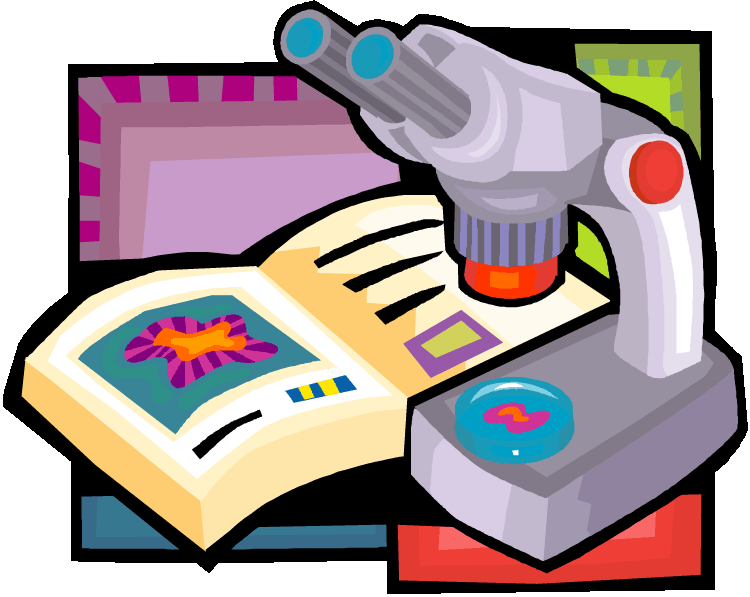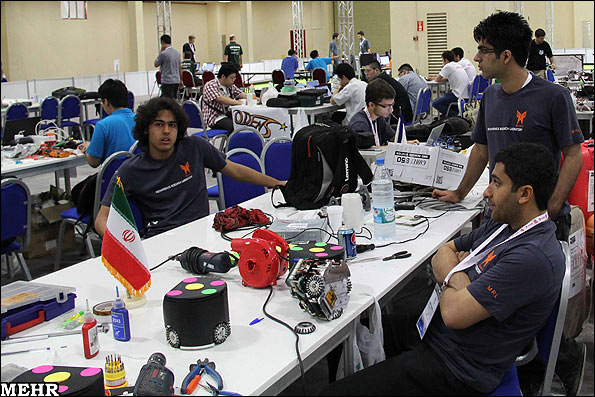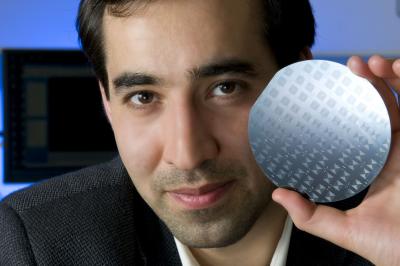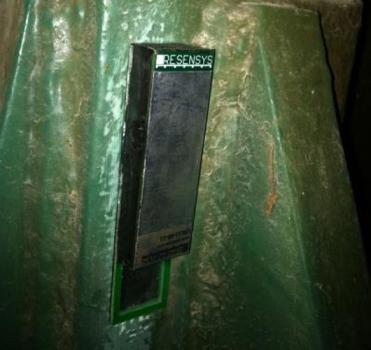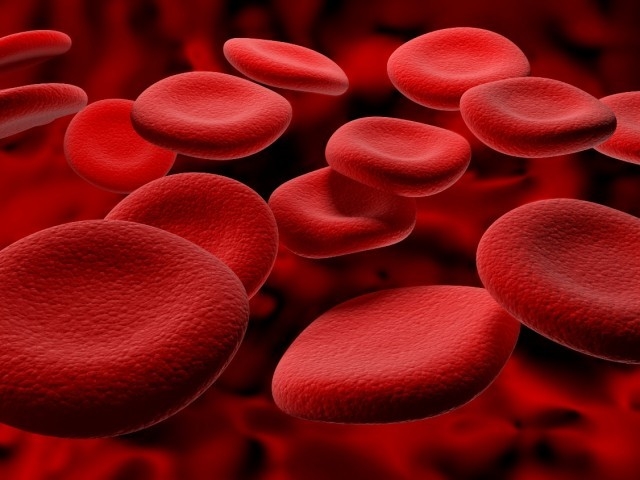Iran Review: September 2011 (Chief Editor-Firouzeh Mirrazavi)
Under the section for “Iranuians’ Achievements” there is an article entitled “Iranians & Sci-Tech Achievements“.
====================================================================
UNESCO to Award 4 Iranian Scientists
The United Nations Educational, Scientific and Cultural Organization (UNESCO) will award four Iranian scientists for outstanding contribution.
The four Iranian scientists have earned their prestigious own spot on the list of Islamic World’s top scholars, which is now being recognized by UNESCO as well, ISNA reported.
The Islamic World Scientists’ Network in conjunction with Iran’s national Biophysics and Biochemistry Association will be offering the prizes to the four senior Iranian experimental science researchers.
The awardees include Dr. Abbas Shafiee, Tehran University Pharmacology and Medical Sciences Professor, Dr. Mojtaba Shamsipour Professor of Chemistry in Razi University, Dr. Mohsen Nemat Gorgani, Tehran University Professor of Biochemistry, and Dr. Ali Akbar Sabouri Professor in Biophysics for Tehran University.
The award ceremony is slated for Saturday (August 27th) and will be held in the presence of the UNESCO National Commission Director General.
Iran’s scientific output rose 18-fold between 1996 and 2008, from 736 published papers to 13,238, making it, as argued by the “New Scientist” journal, as exhibiting the fastest rate of scientific publication increase in the world.
Iranian Researcher: Micro Oxygen Generators Fight Cancer Faster
A tiny oxygen generating device could help kill cancer tissues faster by increasing the influence of radiation and chemotherapy, says a new research.
The device, if implanted in tumours, could shrink them much faster, Purdue University researchers say.
Solid tumours are hypoxic at the core, meaning that they have low oxygen levels, which renders the fight against cancer even more difficult.
“Radiation therapy needs oxygen to be effective,” said Babak Ziaie, professor of electrical, computer and biomedical engineering, the journal Transactions on Biomedical Engineering reports.
“So the hypoxic areas are hard to kill. Pancreatic and cervical cancers are notoriously hypoxic. If you generate oxygen, you can increase the effectiveness of radiation therapy and also chemotherapy,” said Ziaie, who led the study.
The new “implantable micro oxygen generator” receives ultrasound signals… to generate a small voltage to separate oxygen and hydrogen from water, according to a University statement.
“We are putting these devices inside tumours and then exposing the tumours to ultrasound,” Ziaie said.
The ultrasound energy powers the device.
Researchers have tested the device in pancreatic tumours by implanting it in mice. The device generated oxygen and shrank tumours faster. They are slightly less than one cm long. They were created at the Birck Nanotechnology Center at the University’s Discovery Park.
Iranian Elite Ranks Top in the World Optometry Exam
Iranian optometrist Mehran Zarei Ghanavati was celebrated the best eye specialist in the world exam of the International Council for Optometry.
He has passed successfully the exam special for optometrist and received the “Dr. Piter Vatson” reward — six thousand dollars.
The council also awarded him special scholarship to go ahead with his studies.
The first such exam started in 1995 and all eye specialists of the world simultaneously and equally partake the exam every year.
The International Council of Optometry (ICO) is an international optometric organization representing 250,000 optometrists from 96 member organizations in 65 countries.
This year over two thousand of optometrists from 111 eye clinics of the world participated the exam which was held in 65 countries of the world.
The Iranian elite previously ranked top in the Iranian Matrix, exams for the Universities of medical sciences and the pre-internships exam.
He also ranked second in optometrists board exams and first in fellowship cornea exam.
Iran Ranks First in Scientific Growth
Iran’s Deputy Minister of Science, Research and Technology Mohammad Mehdinejad Nouri says the country has the fastest scientific growth in the world.
“Over the past 30 years, Iran has ranked first in the world, with the eleven-fold increase in science growth,” said Mehdinejad Nouri.
He referred to statistics provided by the Institute for Scientific Information (ISI) and pointed out that Iran has produced 12,000 articles in science and research during the first half of 2011, which has gained the country the 21st place in the world in terms of research articles contribution.
The senior official at the Ministry of Science, Research and Technology further pointed out that the number of university students in Iran has almost doubled over the past years.
Mehdinejad Nouri noted that Iran has localized 80 percent of communications and information technologies and also doubled its progress in areas of aerospace, stem cell researches, nuclear, aircraft designs, oil and gas, and biological and chemical engineering.
In March, a report released by UK’s Royal Society said Iran is the fastest growing country in terms of numbers of scientific publications in the world.
The report stated that Iran has had the fastest rate of increase in scientific publication in the world and its scientific output rose 18-fold between 1996 and 2008, from 736 published papers to 13,238.
The United States is still the world’s scientific leader in authorship of scientific research papers, but its share of global authorship has fallen to 21 percent from 26 percent, the report added.
China followed with a share of authorship rising to 10.2 percent from 4.4 percent, with Britain ranking third with a slight decrease in its share from 7.1 percent to 6.5 percent.
Turkey dramatically improved its scientific performance, at a close rate to China, with R&D spending increasing nearly six-fold between 1995 and 2007.
The report also indicated that China is overtaking ‘scientific superpowers,’ in the conduct and impact of science, and its ability to tackle global problems.
According to the report, despite the strained political relations between Iran and the US, the number of collaborative papers between scientists of the two countries rose almost fivefold from 388 to 1831 over the same period.
The report said emerging nations such as Brazil and India are rising above scientific leaders like the United States, Europe and Japan, while Iran, Tunisia and Turkey have entered the league of rapidly emerging scientific nations.
Iranians Win 6 Math Olympiad Medals
Iranian high school students were ranked 10th in the 52nd International Mathematics Olympiad (IMO) held in Amsterdam, the Netherlands, during July 16-24.
Mohsen Jamali, the head of Young Scholars Club (YSC), said the Iranian students won two gold and four silver medals in the competition, ISNA reported.
Mojtaba Shokrian from Isfahan and Mina Dalir-Rouy from Tehran bagged gold medals and Mohammad Pedramfar from Rasht, Erfan Tavakkoli from Amol, Sahand Seif-Nashri and Alireza Fallah from Tehran bagged silver medals.
The competition opened with the participation of more than 560 contestants from 101 countries. The Iranian team had won 4 silver and 2 bronze medals in the previous round of the competition.
“The IMO is the largest and oldest Olympiad for sciences and we will have the honor of receiving around 600 incredibly talented young mathematicians from across the globe,” said Netherlands’ Education, Culture and Science Minister Marja van Bijsterveld before the competition.
The IMO is the top international competition held for high school students. The first IMO was hosted in 1959 by Romania.
With about half of the world’s countries and regions participating in recent years, it has become not only a mathematical competition for young people on the highest level, but also a great moment for international communication.
Iran Ranks 13 in Computer Olympiad
Iran’s national computer team has achieved the 13th place in the world computer Olympiad, which was held in Pattaya, Thailand.
Members of the Iranian national computer team have managed to win three silver and one bronze medals in the 23rd International Olympiad in Informatics (IOI) this year, where 82 countries participated, Fars News Agency reported .
Seyyed Mehran Kholdi, Kasra Edalatnejad Khameneh, and Sajjad Jalali took silver medals and Mohammad-Reza Kasnavi won the bronze medal of the international competition which started on July 22 and ended on July 29.
The Olympiad is led by the Institute for the Promotion of Teaching Science and Technology (IPST).
Iran’s Deputy Minister of Science, Research and Technology Mohammad Mehdinejad Nouri announced the country has the fastest scientific growth in the world.
He referred to statistics provided by the Institute for Scientific Information (ISI) and pointed out that Iran has produced 12,000 articles in science and research during the first half of 2011, which has won the country the 21st place in the world in terms of research article contribution.
Iran Ranks 4th in Int’l Chemistry Olympiad
The Islamic Republic of Iran National Chemistry Olympiad Team, attending the 43rd Global Chemistry Olympiad in Turkey, gained two gold, a silver, and a bronze medal, ranking 4th across the globe.
According to Mehr news agency 273 students from 76 countries took part in the Global chemistry Olympiad in Turkey.
In regard to points gained throughout the Global Chemistry Olympiad, China and South Korea jointly hold the first spot, with Russia and the US respectively holding the 2nd and 3rd spots. Meanwhile, Iran in the company of Czech Republic, France, and India, jointly hold the 4th spot.
The 43rd International Chemistry Olympiad was held in Ankara, Turkey, as of July 9-18.
Iranians Bag 9 Olympiad Medals
Iran won five medals at the 42nd International Physics Olympiad (IPhO) and four medals at the 22nd International Biology Olympiad.
Mohsen Jamali, the head of Young Scholars Club (YSC), said Iran’s team at the 42nd International Physics Olympiad (IPhO) in Bangkok, Thailand, comprised Mehrdad Khani Shirkouhi from Karaj, Pouria Qajari, Masoud Mohammadi and Nima Mousavi from Tehran, and Alireza Kamalipour from Shiraz, ISNA reported.
Iran’s team won five silver medals to rank 10th among 85 countries.
Some 480 students attended the competition, which was held during July 10-18.
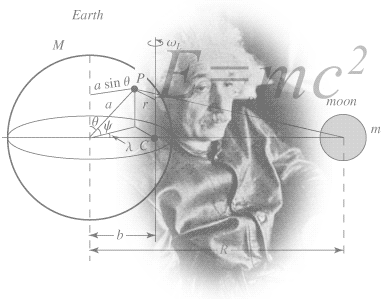
Students from Taiwan and China ranked first and second, respectively.
The organization of the 42nd IPhO in 2011 was previously entrusted to Belgium.
However, in 2010, Belgium’s organizers formally informed the IPhO Secretariat their decision to withdraw from organizing the Olympiad due to a substantial shortfall in funding.
After active efforts of the IPhO Secretariat, Thailand agreed to organize the event.
Iran won two silver and two bronze medals at the 22nd International Biology Olympiad held at Taipei, Taiwan, from July 7-17.
Mohsen Jamali said Iran’s team comprised Mahsima Shabani, Mehrdad Goshayeshi, Ali Vafaei and Ahmad Vafaeian, adding that Iran’s team will return home on July 20.
The Olympiad is the biggest international competition of secondary school students held for promoting different branches of studies by connecting young people from all over the world, giving them the opportunity to exchange experiences, forge new friendships and collaborations in the scientific community and ensure a bright future for the development of physics.
Iran Beats US In RoboCup Contest
Iran beats Japan and US in the international RoboCup competition held in Istanbul, Turkey.
In the first soccer match of Iran, MRL team from Qazvin Open University beat Japanese Hibikino Musashai in middle-sized robots 7-0, ISNA reported.
This is while in the small-sized robots’ soccer match, the Iranian team headed for the second round when it beat US Georgia Tech team 3-0.
The achievement is more valuable in view of the fact that some parts of these robots are among the items sanctioned by the US.
Some 40 teams are representing Iran in 14 leagues of this competition.
The small-sized robot, or F180, focuses on the problem of intelligent multi-agent cooperation and control in a highly dynamic environment with a hybrid centralized/distributed system.
A small-sized robot soccer game takes place between two teams of five robots each. Each robot must conform to the dimensions specified in the F180 rules: The robot must fit within an 180 mm diameter circle and must be no higher than 15cm. The robots play soccer with an orange golf ball on a green carpeted field that is 6.05 meters long and 4.05 meters wide.
More than 200 teams from 57 countries are participating in the competition that is held in three steps in different leagues, including RoboCup Soccer, RoboCup Rescue, RoboCup Junior and RoboCup@home.
Iranian Researchers Produce Nanovaccine for Leishmaniasis
Researchers at Tabriz University of Medical Science have produced Nanovaccine for Leishmaniasis.
Dr. Mohammad Ali Danesh, who led the research, said leishmaniasis is a protozoan disease, affecting 12 million people in different regions of the world with a wide spectrum of diseases, ISNA reported.
“Although several chemotherapeutic agents have been used for treating the disease, long-term therapy, limited efficacy and the development of drug-resistant parasites remain the major limitations,” he said.
To develop a new nanovaccine for leishmaniasis, recombinant Leishmania superoxide dismutase (SODB1) was loaded onto chitosan nanoparticles by the ionotropic gelation method.
He further said size and loading efficiency of the nanoparticles were evaluated and optimized, and an immunization study was undertaken on BALB/c mice.
“The mice received phosphate buffer saline (PBS), superoxide dismutase B1 (SODB1) in PBS and nanoparticles via subcutaneous injection,” he said.
“Soluble Leishmania Antigens (SLA) and complete Freund’s adjuvant (CFA) were also injected subcutaneously three times every three weeks (some groups received only a single dose),” he said, adding that three weeks after the last injection, blood samples were collected and assessed with ELISA to detect IgG2a and IgG1.
He explained that immunological analysis showed that in single and triple doses of SODB1 nanoparticles, IgG2a and IgG2a/IgG1 were significantly higher than the other groups (P<0.05).
Danesh also said the results revealed that formulations of SODB1 in biodegradable and stable chitosan nanoparticles can increase the immunogenicity toward cell-mediated immunity (TH1 cells producing IgG2a in mice) that is effective in leishmania eradication and could be presented as a single dose nanovaccine for leishmaniasis.
Detecting Metastatic Cancer Cells
Research by engineers and cancer biologists at Virginia Tech indicates that using specific silicon microdevices might provide a new way to screen breast cancer cells’ ability to metastasize.
The Virginia Tech researchers are: Masoud Agah, director of Virginia Tech’s Microelectromechanical Systems Laboratory (MEMS) in the Bradley Department of Electrical and Computer Engineering; Jeannine Strobl, a research professor in the same department; Mehdi Nikkhah of mechanical engineering and Raffaella DeVita of engineering science and mechanics and the director of the Soft Biological Systems Laboratory.
Nikkhah was Virginia Tech’s outstanding doctoral student in the College of Engineering for 2009, Eng.vt.edu reported.
Their work appeared in two journal articles they authored in the 2010 issues of Biomaterials, titled “Actions of the anti-cancer drug suberoylanilide hydroaxamic acid (SAHA) on human breast cancer cytoarchitecture in silicon microstructures,” and “The cytoskeletal organization of breast carcinoma and fibroblast cells inside three dimensional isotropic microstructures.”
Cell cytoskeleton refers to the cell’s shape and its mechanical properties, Agah explained. “Any change in the cytoskeletal structure can affect the interaction of cells with their surrounding microenvironments. Biological events in normal cells such as embryonic development, tissue growth and repair and immune responses, as well as cancer cell motility and invasiveness are dependent upon cytoskeletal reorganization,” the electrical engineer added.
Understanding how the cell interacts with the contents of its surrounding environment inside the human body, including the introduction of a drug, is a fundamental biological question. The answers have implications in cancer diagnosis and therapy, as well as tissue engineering, Agah said.
In previous experimentation by others in the field, researchers have exposed cells to mechanical, chemical and three-dimensional topographical stimuli. They recorded the cells’ various responses in terms of migration, growth and the ability to adhere. Also, in the past, researchers have created substrates of precise micro- and nano-topographical and chemical patterns to mimic in vivo microenvironments for biological and medical applications.
What distinguishes the work of Agah, a National Science Foundation (NSF) CAREER Award recipient, and his colleagues, is they developed a specific three-dimensional silicon microstructure for their work. Due to its curved isotropic surfaces, they were able to characterize and compare the growth and adhesion behavior of normal fibroblast and metastatic human breast cancer cells, they reported in Biomaterials.
“In invasive breast carcinoma, tumor cells will fill a milk duct, and the basement membrane,” they wrote. This action allows the carcinoma cells and the fibroblast cells of the breast tissue to be in close proximity, constituting “a critical pathobiological transition that leads to the progression of the disease,” Strobl said.
Using their uniquely designed three-dimensional silicon microstructure, they were able to incorporate three key cellular components found in any breast tumor microenvironment. Additionally, they were able to determine the detailed interaction of the cells within this environment, including the normal breast cells, the metastatic breast cancer cells, and the fibroblast cells.
Their understanding of the behavior of the cells within the microstructures is what leads them to believe their research could “provide important diagnostic and prognostic markers unique to the tumor, which could ultimately be used to develop new tools for the detection and treatment of cancer”.
Following their initial findings, Strobl, Nikkhah and Agah identified a unique application of the experimental anti-cancer drug SAHA in their studies with the silicon microstructure. SAHA, also known as Vorinostat, is the first drug of its type to receive Food and Drug Administration approval for clinical use in cancer treatment.
Unlike many of the conventional cytotoxic chemotherapy agents that target DNA to kill cancer cells, SAHA’s unique properties include its ability to inhibit a family of enzymes referred to medically as “histone deacetylases”. These enzymes are known to “increase levels of acetylation of many proteins, including beta-actin, alpha-, and beta-tubulin, and additional actin binding proteins comprising the cytoskeleton.
“The role of drugs such as SAHA in the control of cancer cell metastasis is only beginning to be understood,” explained Strobl,. “However, our work shows that SAHA elicits a very characteristic cytoskeletal alteration specifically in metastatic breast cells that provides a handle for predicting which breast cells in a cell mixture might have the ability to metastasize.”
Cell motility is “one hallmark of metastatic cancer cells involving the coordinated actions of actin and other cytoskeleton proteins”, Agah explained.
When metastatic disease develops, it is usually fatal.
They found SAHA caused cancer cells to stretch and attach to the microstructures through actin-rich cell extensions. By contrast, control cells conformed to the microstructures.
This result allowed them to “conclude that isotropically etched silicon microstructures comprise microenvironments that discriminate metastatic mammary cancer cells in which cytoskeletal elements reorganized in response to the anti-cancer agent SAHA”.
The Virginia Tech work in this area “is the first to address the use of microdevices to study this emerging class of anti-cancer agents”, Agah said.
Iran-Born Researcher Develops a Warning System For Bridge Dangers
While newer ‘smart’ bridges have embedded wired networks of sensors to monitor their structural integrity, the high cost of installing such systems on existing bridges is simply unaffordable for strained city, state and federal budgets.
According to a 2009 estimate by the US Society of Civil Engineers, more than one in four US bridges are either structurally deficient or functionally obsolete, Gizmag said.
Now University of Maryland electrical engineering researcher, Iran-born Mehdi Kalantari, has developed a tiny wireless sensor that monitors and transmits minute-by-minute data on a bridge’s structural integrity that he estimates is one-hundredth the cost of a wired network approach.
The wireless sensors, which Kalantari is marketing under the name SenSpot, measure all the variables reflecting the structural integrity of bridges that conventional wired systems do, such as strain, vibration, tilt, acceleration, deformation and cracking.
The sensors themselves are less than five millimeters thick and are comprised of four thin, flexible layers. The first senses and measures structural parameters; the second stores energy; the third transmits data to central computer for analysis; and the outer layer harvests energy from ambient light and radio waves.
While serious problems would quickly trigger an alarm, more subtle early-stage problems may take up to a few days until the system is confident enough to report a structural integrity issue.
Kalantari says the sensors are rugged and, because they are self-adhesive, require no potentially damaging drilling into the bridge structure. “They should last at least a decade with practically no maintenance required. As they harvest energy from ambient light and radio waves, they don’t require any wires, batteries or dedicated external power source,” he said.
With each unit costing about US$20, the total cost for an average-sized highway bridge needing about 500 sensors would be about $10,000.
“If this kind of technology had been available in Minnesota four years ago, there’s a good chance the fatal bridge collapse could have been avoided,” Kalantari says, referring to the August 1, 2007 bridge collapse along Minneapolis I-35W that killed 13 and injured 145. “This new approach makes preventive maintenance affordable–even at a time when budgets are tight. Officials will be able to catch problems early and will have weeks or month to fix a problem.”
In conjunction with the Maryland Department of Transportation, Kalantari has been testing the sensors by measuring the structural parameters of highway bridges in a real setting for almost a year. He says this has allowed him to optimize the device’s performance and energy consumption with the updated model smaller and 10 times more energy efficient than its predecessor. The field testing has also allowed him to track the bridges’ response to changes in weather conditions and traffic.
To commercialize his technology, Kalantari founded Resensys LLC through the University of Maryland’s Technology Advancement Program incubator. He expects to scale up production of the sensors in September this year.
Dr. Kalantari received his BSc and MSc degrees in electrical engineering from Sharif University of Technology, Tehran, in 1996 and 1998, respectively. After gaining several years of industry experience in control and communication systems during 1996-2000, he started his PhD studies in electrical and computer engineering at UMD in 2000.After receiving his PhD in 2005, he has worked there as an assistant research scientist.
Dr. Kalantari received Dean’s Honor Award of the Sharif University of Technology in 1996, Business Plan Competition Award of UMD in 2004 and the Award for Entrepreneurship of UMD in 2006.
Treating Refractory Diseases With Stem Cells
Iranian researchers at Tehran Medical University used embryonic stem cells to treat refractory diseases.
Ramin Heshmat, the deputy head of the university’s Endocrinology and Metabolism Research Center, said the scientists used embryonic stem cells to treat diabetes, MS, liver disease and dystrophy, IRNA reported.
“In this process, researchers inject these human cells into patients,” he said. “This is a much more controlled process and you basically are sure of getting the same quality of cell every time you do the implant.”
Heshmat pointed out that currently a patient would have to wait for a cadaver organ to become available and even then there is a high risk of the cells from that organ being infected or contaminated.
“If we use embryonic stem cells instead, we can also make unlimited numbers of these cells and have an unlimited source that we can stockpile and have available whenever a patient needs it,” he said.
Embryonic stem cells are pluripotent stem cells derived from the inner cell mass of the blastocyst, an early-stage embryo. Human embryos reach the blastocyst stage 4–5 days post fertilization, at which time they consist of 50–150 cells.

